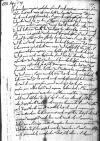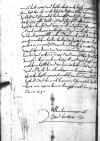Hochwirdiger in Got Geliebter Freund.
Nach erpitung meiner freuntlichen dinst und wes ich mer liebe und guttes vermag.
Zuvor thu ich mich gantz freuntlich Ewer Lieb eigen hantschrifft schreibens bedancken, weil den in dem sellygen eingeleibt und mir von Ewer Lieb newen anderm geraten wurt, das ich mich der acht nit zu hoch bekummer wolle, den weil Got der almechtig meinner nach filen iaren mit gnaden wiederumb hingeholffen, so wol mich Ewer Lieb wol zu gelegner zeit filerlen berehten was Ewer Lieb mit Charles V of Habsburg (*1500 – †1558), ruler of the Burgundian territories (1506-1555), King of Spain as Charles I (1516-1556), King of Naples and Sicily, King of the Romans (1519-1530), Holy Roman Emperor of the German Nation (elected 1519, crowned 1530, abdicated 1556); son of Philip I the Handsome and Joanna the Mad of Castile
Ferdinand I of Habsburg (*1503 – †1564), from 1521 Archduke of Austria, from 1526 King of Bohemia and Hungary, Croatia and Slavonia as Ferdinand I, 1531-1558 King of the Romans, 1558-1564 Holy Roman Emperor; son of Philip I the Handsome and Joanna the Mad of Castile, a younger brother of Charles V of Habsburg⌊keyserlichen Romischen und koniglichen maiestetCharles V of Habsburg (*1500 – †1558), ruler of the Burgundian territories (1506-1555), King of Spain as Charles I (1516-1556), King of Naples and Sicily, King of the Romans (1519-1530), Holy Roman Emperor of the German Nation (elected 1519, crowned 1530, abdicated 1556); son of Philip I the Handsome and Joanna the Mad of Castile
Ferdinand I of Habsburg (*1503 – †1564), from 1521 Archduke of Austria, from 1526 King of Bohemia and Hungary, Croatia and Slavonia as Ferdinand I, 1531-1558 King of the Romans, 1558-1564 Holy Roman Emperor; son of Philip I the Handsome and Joanna the Mad of Castile, a younger brother of Charles V of Habsburg⌋ mih andern gerat dar durch zufernomen das meiner bekumernus nit so hoch von acten und beschlislich thun sich Ewer Lieb mit freuntlichem erpiten mir befolen etc.
Nun danck ich Got und ist mir auch an besundre freud das der almechtig Ewer Lieb mit gesuntheit und wolfart widerumb heimbgeholffen nit weniger wer mir erfreulich, so es sich zutragen mocht, das wir uns freuntlich miteinander besehen und unterreden mochtenden wy wol mir Ewer Liebgar treulich raten, das ich mich nit zuhoch bekumern wol etc., des rat ich mich auch freuntlich bedancken ihn und ob mir Got sein gnad verleihet das ich fur mein person yme alles befele und ergewe haben doch Ewer Lieb zuermessen. Was mein getrewe unterthon in solchem anfechten mag sund erlich weil ethlichen zumb theil auch ein abtrack solcher acht zugeschick welchen ich weiter hieneben Sigismund I Jagiellon (Zygmunt I) (*1467 – †1548), King of Poland and Grand Duke of Lithuania (1506-1548); Duke of Głogów (Glogau) (1499-1506), Duke of Opava (1501-1506), Governor of Silesia (1504-1506); son of King Kazimierz IV Jagiellon and Elisabeth of Austria⌊koniglicher maiestatSigismund I Jagiellon (Zygmunt I) (*1467 – †1548), King of Poland and Grand Duke of Lithuania (1506-1548); Duke of Głogów (Glogau) (1499-1506), Duke of Opava (1501-1506), Governor of Silesia (1504-1506); son of King Kazimierz IV Jagiellon and Elisabeth of Austria⌋ unnsser gnedigen herr zugeschickt nun ist ie pillich, das ich mich meiner getrewen untterthon bekumernus auch ansichten las.
So ich wil meiner vergessen wolt, dem nach wolt ich Ewer Lieb gepoten haben wo Ewer Lieb einige mittel wusten, domit mein getrewer volthaten zu friden gestelt mocht werden Ewer Lieb wol mir solhe auch freuntlich mittheilen. Das sich aber Ewer Lieb legen mir so hoch erpiten und befelen thut auch durch Nikolaus Nibschitz (Mikołaj Nipszyc) (*ca. 1483 – †1541), royal courtier, diplomat in the service of Sigismund I and Albrecht von Hohenzollern-Ansbach, Dantiscus' friend; from 1525 until his death an official representative of Duke Albrecht at the Cracow royal court; from 1532 royal secretary; 1519 royal envoy to Albrecht von Hohenzollern, Grand Master of the Teutonic Order, 1525, 1526 envoy to Hungary, 1527 envoy to the Congress in Wrocław, 1531-1533, 1537 envoy to Ferdinand I of Habsburg, 1535-1537, 1540 envoy to Brandenburg, 1536 envoy to the estates of Livonia⌊NipschitzNikolaus Nibschitz (Mikołaj Nipszyc) (*ca. 1483 – †1541), royal courtier, diplomat in the service of Sigismund I and Albrecht von Hohenzollern-Ansbach, Dantiscus' friend; from 1525 until his death an official representative of Duke Albrecht at the Cracow royal court; from 1532 royal secretary; 1519 royal envoy to Albrecht von Hohenzollern, Grand Master of the Teutonic Order, 1525, 1526 envoy to Hungary, 1527 envoy to the Congress in Wrocław, 1531-1533, 1537 envoy to Ferdinand I of Habsburg, 1535-1537, 1540 envoy to Brandenburg, 1536 envoy to the estates of Livonia⌋ thun lest thu ich mich hohes unnd freuntlichen erpitens g[antz] hochlich und freuntlich bedancken und sol Ewer Lieb gewies se[in], das sy mir also befolen ist und sein sol, als mein eig[ner] leiplicher bruder und warin ich Ewer Lieb gedinen kan, pit [ich] Ewer Lieb wol auch gar nicht sparen und auch als iren fre[unt] un bruder gewislich erkennen wil mich auch hiemit [al] gantz trewlichen befelen haben und pitten, wo es Ewer Lieb ge[lo] genheit ie ein mol sein wurde, Ewer Lieb wolle dy mittel und weg suchen, domit wir uns untereinander freuntlich bereden und erkennen magen und nur solhes zeitlichen zuwissen thun mich auch pey Sigismund I Jagiellon (Zygmunt I) (*1467 – †1548), King of Poland and Grand Duke of Lithuania (1506-1548); Duke of Głogów (Glogau) (1499-1506), Duke of Opava (1501-1506), Governor of Silesia (1504-1506); son of King Kazimierz IV Jagiellon and Elisabeth of Austria⌊koniglicher maiestetSigismund I Jagiellon (Zygmunt I) (*1467 – †1548), King of Poland and Grand Duke of Lithuania (1506-1548); Duke of Głogów (Glogau) (1499-1506), Duke of Opava (1501-1506), Governor of Silesia (1504-1506); son of King Kazimierz IV Jagiellon and Elisabeth of Austria⌋ und hoff in freuntlichem befellich und vordernus haben.
Das wil ich umb Ewer Lieb dy ich dem almochtigen in langwirtcher ges[u]ntheit thu befelen, gant freuntlich verdinen vergleichen u[nd] beschulden und thu mich hiemit Ewer Lieb freuntlich befelen.


